About the Poet:
Robert Burns was a Scottish poet and lyricist. He is generally thought to be the national poet of Scotland because he is the most widely read among all poets who have written in the Scots language. Burns has also written in English and a light Scots dialect so that his poetry would be understood by an audience beyond Scotland as well. He has even written in standard English.
The volume of works by Burns which came to be known as Poems, Chiefly in the Scottish Dialect came out in 1786. Also called the Kilmarnock volume, it contained much of his best writing.
In 1791, Burns was requested to write lyrics for The Melodies of Scotland, and he responded by contributing over 100 songs. He made a lot of contributions to George Thomson‘s A Select Collection of Original Scottish Airs for the Voice and also to James Johnson’s Scots Musical Museum.
In addition to making original compositions, Burns also collected folk songs from across Scotland, often revising or adapting them. While “Scots Wha Hae” has often served as an unofficial national anthem of the country, “Auld Lang Syne” is famous as a song of farewell.
About Address to a Haggis:
“Address to a Haggis” is a humorous tribute to a hearty Scottish dish made of meat, oatmeal and spices. It is made up of 8 stanzas. Each of these stanzas is again made up of 6 lines. Hence the entire poem consists of 48 lines in total. This poem is written in the first person, and hence we can assume that the speaker of the poem is the poet himself.
Summary of Address to a Haggis:
Stanza 1:
In this stanza, the poet expresses his appreciation upon seeing a plate of haggis put before him. He says that haggis is a filling and unpretentious dish. It is also the most superior among all dishes made of sausage. Since the haggis is made up of the liver, lungs, and heart of a sheep chopped and boiled within the sheep’s stomach, it is better than the sum of its ingredients. The poet also says that the haggis is as long as his arm, and so it deserves to be honored by all.
Stanza 2:
In this stanza, the poet tells the haggis that it covers the entire plate on which it is served. Its buttocks are so round and full that they appear to be like hills. The skewer by which the meat is held together is so long that it could hold up a collapsing mill. The pores on the haggis allow the amber-colored stew inside to form droplets of dew on its surface.
Stanza 3:
In this stanza, the poet introduces a man who has been given the job of carving up the haggis and serving it. He begins by polishing his knife and then cuts through the meat without any apparent effort. With his knife, it seems he is digging a ditch in the innards of the haggis, and out of that ditch flows out the delicious stew inside, spreading a rich and appealing aroma.
Stanza 4:
In this stanza, the poet describes a group of diners feasting on the haggis. He says that each man takes up his spoon and starts competing with the others for the largest portion. The slowest one gets the last piece. Even so, the men all keep eating for a long time until finally, all their bellies swell up and become as tight-stretched as the skin on a drum. The person at the head of the table is most likely to burst and he thanks God that his stomach is still intact.
Stanza 5:
In this stanza, the poet ridicules French food such as ragout. Of the folio stew, he says that it can bloat you up without filling your stomach. Of the fricassee, he says it can cause nausea. In contrast to these dishes, the Scottish haggis is one that no one could look down upon or reject the chance to devour.
Stanza 6:
In this stanza, the poet pokes fun at people who eat French dishes. He says they are as feeble as reeds. Their legs are so skinny that they appear to be the ends of whips. Their fists are as small as hazelnuts. Such men will surely never be fit enough to fight on land or at sea.
Stanza 7:
In this stanza, the poet presents a picture of the man from the Scottish countryside who feeds on haggis regularly. He is so sturdy that the ground he walks upon trembles. The poet is sure that he will be able to put even a blade to good use, decapitating men as easily as he would the tops of thistles.
Stanza 8:
In this stanza, the poet speaks to the supreme powers who are responsible for providing mankind with food. He tells them that Scottish men are not satisfied with watery dishes that will splash around in the bowls they are served in. Instead, if they are given haggis, they will be forever grateful.
Critical Analysis of Address to a Haggis:
This analysis of Robert Burns’ “Address to a Haggis” is divided into three sections – context, rhyme scheme and rhetorical devices, and themes.
The context of Address to a Haggis:
This poem first appeared in the Caledonian Mercury on 20th December 1786 and then in the Scots Magazine for January the next year.
Today it is customary to begin proceedings with this poem and then with the serving of the haggis at the anniversary celebrations of the poet’s birth every year.
Rhyme Scheme and Rhetorical Devices of Address to a Haggis:
Most stanzas in this poem follow the rhyme scheme AAABAB. This kind of rhyme scheme was Burns’ favourite and was known as the standard Habbie, after the Piper Habbie Simpson. It is also sometimes known as the Scottish stanza or the six-line stave. The 2nd, 3rd and 6th stanzas follow this pattern exactly, and the rest occur with only minor deviations from the structure.
Throughout this poem, the poet uses the device of an apostrophe. This rhetorical device is used when a poet addresses his or her poem to an absent or silent audience. Here the poet speaks directly to the haggis, and to the powers that are responsible for feeding mankind, but we do not see either responding to him at any point in the poem.
In line 2 of the 1st stanza, the poet uses the device of personification with respect to haggis and other sausage-based foods. This rhetorical device is used to bestow human qualities on something that is not human. Here the poet imagines foods to be divided amongst themselves by race, and haggis to be the chieftain of the race of sausage-based foods.
On many instances in the poem, the poet uses the device of simile. This rhetorical device is used when an overt comparison is made between two different things. In line 2 of the 2nd stanza, the poet compares the buttocks of the haggis to hills. In line 3 of the 3rd stanza, he compares the cut in the innards of the haggis with a ditch. In line 4 of the 4th stanza, he compares the bellies of the men who have eaten the haggis with drums. In line 2 of the 6th stanza, he compares the men who eat French dishes with reeds.
Themes of Address to a Haggis:
Mock epic:
Mock-epic (also known as a mock-heroic) poetry draws heavily on the technique of satire, which means that it uses irony, exaggeration and sarcasm to mock its original subject, usually in an undignified and grandiose manner. That is exactly what happens here. The poet speaks in an exaggerated manner about the virtues of the haggis as a dish fit for Scottish warriors. Every comparison he uses is a hyperbole, most notably where he says that the skewer holding the haggis together could also hold up a collapsing mill. In order to show how the haggis is superior to all other food, the poet imagines it to be the chieftain of a race of sausage-based foods. He also unhesitatingly disparages Frenchmen and their food. Ultimately he comes to the conclusion that Scottish men become sturdy and intimidating by feasting on haggis on a regular basis. The poem is humorous and entertaining as a whole because of the use of such grandiosity in description and sarcasm in tone.
Scottish heritage:
The haggis is a typically Scottish dish, and hence it becomes a sign of Burns’ patriotic nationalism. In the aftermath of the French Revolution and the American War of Independence, the Scottish were much encouraged to pursue their own separation from England. In service of such a separation, poets such as Burns took it upon themselves to show their countrymen how proud they ought to be of their own heritage and how they should labour to preserve that heritage. In doing so, poets like Burns hoped that the Scottish would learn to stand up for themselves and fight for their right to exist as independent peoples in an independent nation. Moreover, the haggis could serve to strengthen the Scotsman’s body and help him win battles on land or on the sea.
Conclusion
“Address to a Haggis” is a humorous tribute to a hearty Scottish dish made of meat, oatmeal and spices. It is made up of 8 stanzas. Each of these stanzas is again made up of 6 lines. Hence the entire poem consists of 48 lines in total. This poem is written in the first person, and hence we can assume that the speaker of the poem is the poet himself.
Some online learning platforms provide certifications, while others are designed to simply grow your skills in your personal and professional life. Including Masterclass and Coursera, here are our recommendations for the best online learning platforms you can sign up for today.
The 7 Best Online Learning Platforms of 2022
- Best Overall: Coursera
- Best for Niche Topics: Udemy
- Best for Creative Fields: Skillshare
- Best for Celebrity Lessons: MasterClass
- Best for STEM: EdX
- Best for Career Building: Udacity
- Best for Data Learning: Pluralsight
















